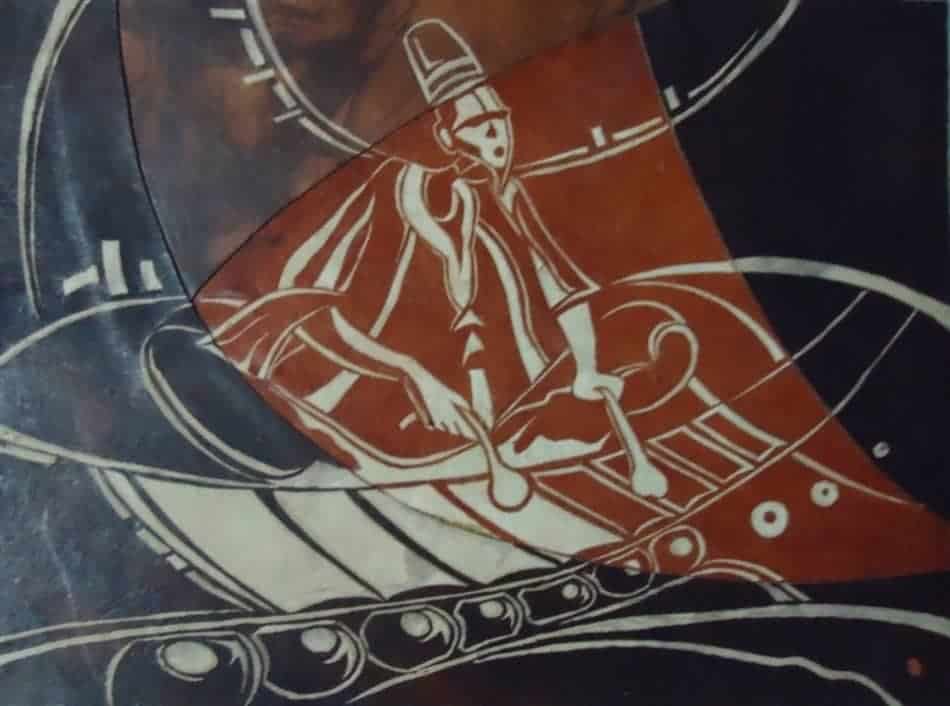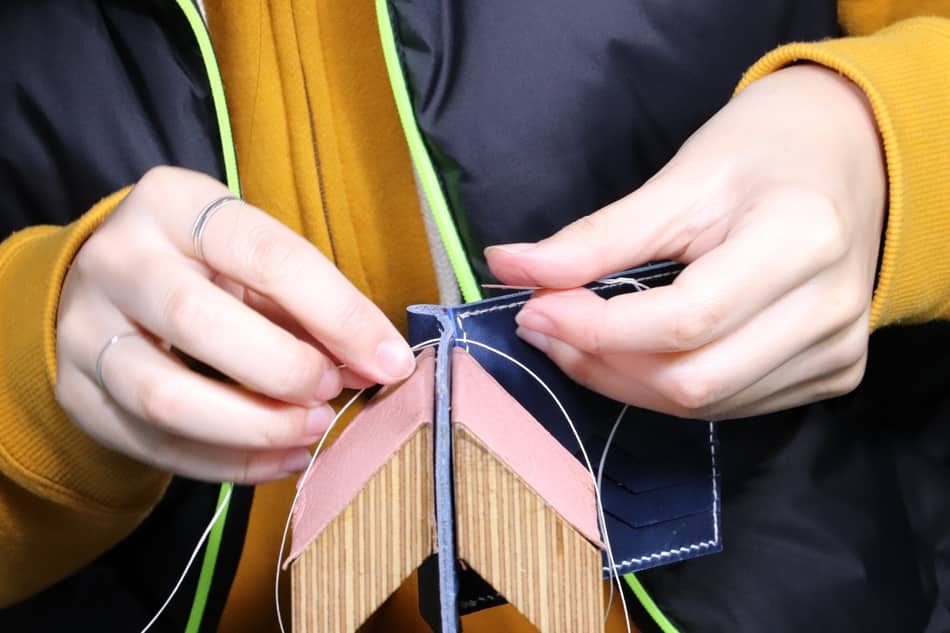Looking to have your leather decorated? Chances are you know there are a lot of Decorative leather techniques. In this article, we will thoroughly give you details on the various decorative techniques leaving nothing out.
Decorative Leather Techniques
- dyeing
- incision
- painting
- tooling
- Weaving
- applique
- stamping
- scorching/pyrography/burning
Overall, there are plenty of leather decorative techniques for you to consider when working with leather. Vegetable-tanned leather is the most suitable and useful for the aforementioned leather decorative techniques.
From my 15 years experience in leatherwork, I will say the Leather decoration process starts with the turning of skins and hides into the leather (Tanning). Usually, after tanning the leather will generally have a color depending on the tanning method used. Leather does not only get decorated by coloring but also by using other decorative techniques we will be discussing in detail below.
Tip: Whichever decorative technique a leather artist chooses to use should be simple and adhering to the elements and principles of design.
Details on Leather Decorative Techniques
1. Dyeing Leather
Dyeing just as the name implies is when we apply pigments mixed with solvents like water on the grain surface of the leather to make it look beautiful and colorful. Leather dyes adhere to the pores of the leather. This means when you dye leather, the pigment applied goes deep into the pores of the leather, making die effect more permanent.
Dyeing and staining are synonymous terms that can be used interchangeably. It is one of the oldest methods of decorating leather items. There are oil, alcohol, and water-based leather dyes available on the market today.
Cheaper water-based dyes are temporal while spirit-based dyes are on the other hand are more expensive and permanent.
Leather dyes
Leather dyes can be bought from the supermarket or homemade. Leather dyes can be made from seeds and barks of certain trees like the ‘Bagalura’ tree commonly found in the West and Central parts of Africa.
Homemade Leather Dyes with Lime Solution and Metal Pieces
Alternatively, Leather dyes can also be made from lime juice, water and rusted metal pieces like nails.
The metal will combine with citric acid in the lime to create a chemical bond that effectively dyes leather. It gives a brown to black dye depending on how long you leave the dye to mature. The longer the dye is kept, the richer and darker it becomes and can be kept for years without spoilage.
When making dyes at home using metal pieces and lime solution, be sure to wear protective gloves and keep hands washed after working with such dyes.
I will however highly recommend buying an oil or alcohol dye of your choice to speed up your leatherworking process.
Once your preferred dye is ready, you can now choose from the leather dyeing methods below. Indeed there various methods for dyeing leather. They are explained below.
Leather Dyeing Techniques
Leather dyeing techniques are the various methods you can use in dyeing leather to reach unique dye patterns and effects. There are:
- Tie and dye method
- Marbling method
- Splashing method
- Folding method
- Spiral method
2. Stamping Method
Stamping leather is a very popular leather decorative technique. It is done by using decorative metal stamps to imprint designs on the grain surface of the leather with the help of a mallet.
There are so many different types of commercially made stamping tools available for sale. All you do is buy the designs of your choice. The imprint is done by:
- Making the grain surface of your leather moist
- Place the leather on cardboard and place the cardboard on a firm surface like a wooden board.
- Position your stamping tool on the leather.
- Use a wooden mallet to hit the stamping tool.
- You can repeat the process as you want.
3. Incision Method

Incision is my personal favorite leather decorative technique and I am sure you will love it as well. Incision is when you use an incision tool to remove the top layer of the grain side to reveal an underlying layer of leather to create a design. You can go wild with Incision by combining it with other methods for portraits on leathers. Enjoy!
4. Tooling Method
Tooling is a very simple technique. You can use a stylus to create patterns, lines or outlines. Before you start, you wet the leather after which you use your stylus to make any designs of your choice on the leather and leave to dry. Most artists improvise the stylus with an empty ball pen. You can do tooling on almost all leather items you design.
5. Weaving Method
You will absolutely love this method. It is said to be one of the commonest methods of decorating leather. Weaving is the interlacing of two or more sets of leather strips to form a woven pattern just like you will see on most women. Different colored strips of the leather can be used as well.
6. Burning / Pyrography/Scorching Method
This is like giving leather a tattoo. It is burning design on leather with dry heat from a soldering iron. You need to exercise caution as the soldering iron used can really get hot. It is popularly known as pyrography. Vegetable-tanned, chrome tanned and suede are excellent leather surfaces for burning.
If you’re interested, you can check out this high quality pyrography tool from Amazon!
It results in a monochromatic effect on your leather. However, you can create sharp contrasts to break the monotony and boredom that might result. The burning method can be used to create some dramatic effects on leather. A variety of dots, lines, textures shades can be applied to create a truly masterpiece for your works. Cross-hatching and the use of multiple lines help to introduce different tones, fire, and drama in your work.
You can check out this awesome pyrography guide on Amazon. It will walk you through all the basic and some cool techniques to make your pyrography look like that of a pro!
7. Applique Method
Applique is French meaning to “apply on”. In terms of decorating leather, it is basically cutting pieces of leather of different shapes sizes, textures, colors and fixing them with leather glue on a bigger surface leather. Sometimes, the glued leather can be stitched to make it more stronger. You can also go wild with this technique as it is very easy and you just cut and paste whatever desired shape.
Applique method will come in handy especially if you have a lot of leather scraps lying around your studio. There are two types of applique:
- On-lay applique: This literally defines what has been explained above.
- In-lay: But with the inlay applique, you cut out a hollow shape from a bigger leather and then use a smaller leather that has a different color to seal off the hollow space.
This technique is commonly used on leather articles like babies and children’s sandals and shoes, men’s sandals, some lady’s handbags.
8. Modeling Method
Modeling leather has nothing to do with the runway or cat walking. Modeling is a decorative technique of causing a raised effect on the leather.
Calf leather is the best leather for modeling techniques. There are two ways of modeling designs on leather. Theses are:
- Flat modeling
- Relief modeling
Flat Modeling
This decorative technique is done by tracing the outline of a design on a leather surface and then pressing down areas around the outline to cause the part within the outline to raise. The use of an ordinary spoon is very common with this method.
Relief Modeling
You might have seen this decorative technique a thousand times. This is done by placing a cutout shape and fixing it permanently against the flesh side of the leather and then pressing down the edges of the shaped design for it to show through the grain side. The difference between this and the flat modeling technique is the attachment of a shaped object to help hold the design in place.
To learn more on leather modeling, you can check out an article I wrote earlier over here.
9. Patchwork
This leather decorative technique also finds a great use for your leather offcuts. Patchwork is when different pieces of leather offcuts are joined together to form a regular whole or to form a decorative whole. In this technique, several scraps of leather pieces are joined by gluing or sewing together. It can be used to create nice patterns for wall hangings, bags, clothes, belts, and so many leather items.
The edges pieces of leather scraps may overlap for easy gluing and stitching. The most popular stitching technique for this decorative technique is the zigzag stitch.
10. Painting
Painting is the application of paint (acrylic, oil, watercolor, etc.) on a surface such as a canvas. In leatherwork, painting as a decorative technique is applying special leather paints, colored dyes, and inks on leather.
Related Questions
What are the reasons for decorating leather? Leather products are generally decorated for various reasons.
- Firstly, leather products could be decorated to enhance the value of the work.
- Decorating a leather item makes it unique
- Some decorative techniques make the leather more durable
- Makes it more attractive
What are the most common leather decorative techniques?
- lacing
- using fittings and fasteners
- burnishing

